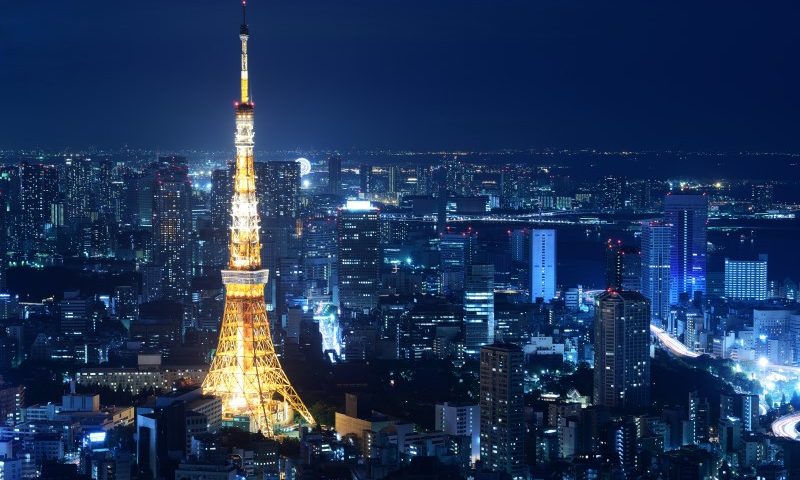Robot capital Tokyo wins 11th annual city rankings of 500 cities ahead of London, England

Cities become smarter as tech solves city problems of two globe-shaking trends
Tokyo was the first Asian city to be named the world’s most innovative city in 2018 in the 11th annual Innovation Cities Index.
The top five in the cities ranking included previous winners London, England (won 2015, 2017), Silicon Valley (San Francisco-San Jose), and New York, followed by Los Angeles. Singapore rose one place behind previous early double winner Boston, Toronto, Paris, and Sydney rounding out the global top ten.
Sydney was also the first Australian city in the top 10. (This marked the first time that three cities in the top 10 had been located in the Asia region.)
According to the analysts (from data innovation agency 2thinknow in Melbourne, Australia), Tokyo’s gradual climb was based off a strong baseline performance average across the broad-base of 162 city indicators used to score the cities, and a focus on applied technology as a unique solution to current urban opportunities and challenges.
Behind the rankings is the analysis that cities with higher rates of innovation will experience higher economic output and be perceived as the best destinations to invest in commercial product, service, or social innovation without a specific industry focus.
“What really surprised us this year, was the resurgence of Tokyo, moving up to eclipse rival cities like Boston. They showed clear direction by embracing smart technology change to lead innovation, and leadership in what we have identified as the twin long-term globe shaking trends of robotics and 3D manufacturing,” 2thinknow’s Director Data, Christopher Hire, stated. “While it was close between London and Tokyo, support of new technologies gave it to Tokyo based on 2018 trends, although this could change in 2019.”
The Innovation Cities Index has been published annually since 2007 by commercial data provider 2thinknow to measure each cities pre-conditions for innovation, using 162 indicators based on commercial data points sold to corporations.
Classifying Cities Globally
The city ranking classified five hundred cities into four bands for innovation based on trend-adjusted scores derived from 162 indicators, which are annually benchmarked and reduced to three factor scores for measuring conditions conducive to creating a process of innovation in a city.
The top band was “Nexus” cities, of which, there were 52 cities (approximately the top 10 percent). There were 120 cities in the next “Hub” category (about 25 percent) and 256 cities (or about 50 percent of cities considered) were in the next globally competitive “Node” category. According to the research model Nexus cities remain the optimal locations for innovation of a general nature, and Hub cities remain optimal for innovation in a few key industry segments.
After the classification process, the cities are ranked by the analysts.
Top Global Nexus Cities
In North America, there were 23 Nexus cities compared with 19 last year, indicating a renewed United States and Canadian city dominance of innovation. Cities that improved dramatically in the ranking due to favourable trends and improved economic development included: Chicago (11), Dallas-Fort Worth (13), Seattle (15), Houston (17), Austin (29), Denver (31), and Philadelphia (32).
In Europe, there were 19 Nexus cities, reversed from 24 cities last year due to declined economic conditions that provided a slower market rate of adoption of innovations, according to the analysts. There were fewer rising cities in Europe, but some included Berlin (13), Oslo (36), and Rome (47).
Last year’s high-ranked European capitals that fell, but retained high positions, are: Amsterdam (18), Vienna (19), Munich (21), Barcelona (30), Madrid (38), Copenhagen (39), and Milan (40). This was due to less favorable trends and distractions from a local policy focus on economic development and innovation during the period, according to the analysts.
As in 2017, nine of the top Nexus cities remained in Asia, including Seoul (12), Hong Kong (27), and Shanghai (35), now topping Beijing (37) and Osaka (45).
Dubai (33) remained the only Emerging Nexus city, although Tel Aviv remained a highly ranked (44) competitor in the Mid-East region, with the next regional city being Abu Dhabi (69), trailed by Kuwait City (268) and Doha (294).
Africa’s top innovator remained Cape Town (265) and Johannesburg (380), although both cities declined due to the economic implications of recent policies.
Region – Americas
Silicon Valley: A story of satellite cities
In the United States, Los Angeles and a series of Bay Area satellite cities such as San Diego (23), Portland (41), Oakland (up 12 places to 43), Sacramento (up 21 places to 59), and Santa-Ana-Anaheim (up 37 places) reinforced their destination attractiveness to tech companies priced out of the San Francisco Bay Area in the analysis.
Oakland was noted as especially significant, having capitalized on the success of being in the Bay Area while also having a distinct city program and overcome past economic issues.
North America tech resurgence
“This year, innovation is likely to come from large cities as usual, but we found on a population-adjusted basis [that] many small cities are punching above their weight,” Hire added. “It’s the year of big cities with physical networks and small cities with digital networks going global.
North American cities were represented in the top hundred cities with 37 cities in the United States, five in Canada, and Mexico City (73) being the new winner in Latin America, replacing Sao Paulo and Rio De Janeiro. This left 43 cities in the top 100 in the NAFTA Zone.
Larger Canadian cities continued their top rankings with few changes due to high costs, including Montréal (22), Vancouver (25), and Québec City (58).
Lower business costs and improved innovation policies lead Ottawa (126), Halifax (202), and Hamilton (205) to achieve above average positions relative to their smaller populations, with potential to improve in future years.
Outside the top hundred innovation efforts by cities like Detroit’s (80) neighboring small city Ann Arbor (up 51 places to 114) and Des Moines in Iowa (up 26 places) could be seen in their movements. The analysts noted the start-up and tech scenes appearing in American cities are providing “strong grass roots of opportunity positivity in the U.S. economy.”
A lot of this was noted as due to the movement of new product ideas “as a service” (e.g., SAAS – Software as a Service, FAAS – Fashion as a Service, or MAAS – Mobility as a Service), enabling new ways of monetizing undervalued assets in the digital economy.
Latin tech tango challenge
The top 10 Latin American cities moved up an average of 11 places each, showing that Latin American capitals were challenging and growing distinct identities from cities of the United States. The fastest movers were Bogota (up 46 places) and Santiago (up 23 places) off improved start-up and more stable business policies.
Region – Europe
Brexit weakens Europe, not U.K.
Because the index factored in economic performance, Europe scored fewer cities than usual, with 35 in the top hundred but with improved performance by Stockholm (28) and Oslo (36), with Athens (62) and Lisbon (rising 17 places to 90) recovering.
Strong mobility solutions (such as an embedded fast rail network) were noted as a key performance differentiator enabling European cities to maintain a strong performance across the data-set. Sustainability performance also played a big part in European cities’ strong performance when smaller populations are accounted for.
The number of cities reduced further to 27 for Continental Europe, once the four Brexit cities of London, Manchester (34, up 11 places), Edinburgh (89) and Glasgow (95), and four other non-continental cities are excluded – Tel Aviv (44), Istanbul (53), Moscow (48), and Saint Petersburg (93).
Outside the top 100, often-overlooked Liverpool (up 22 places to 129) and Leeds (up 13 places to 150) proved that London’s recent last few years of innovation success had now begun transferring to other cities in the United Kingdom.
The European Union had 25 percent of the cities in the top hundred, once Helsinki and Zürich are excluded (not European Union members).
Region – Asia & Oceania
Asian innovation is spiky
The total number of top hundred cities in Asia fell by one (to 18 from 19) due to Perth (now 105) and Guangzhou (113) being jumped by newcomer Wellington (100).
Overall, in the top 100 cities, Asia region improved by an average of three places, and five places in the top 35 percent of all cities. Analysts attributed to a “spike” factor of wealth concentration in Asian society, reflecting a greater concentration of innovation to fewer locations in Asia, compared with the greater distribution more equitably within European society. In practice, this means location matters more in starting new ideas in Asia than in Europe or the United States.
Beyond Nexus cities, other key Hub cities in Asia region included Brisbane (54), Shenzhen (55), Taipei (60), Kyoto (64), Busan (68), and Kuala Lumpur (99).
In Australia, more overlooked regional and smaller capital cities marched upwards, including Canberra (152), Adelaide (163), Gold Coast (198), Wollongong (262, up 38 places), Hobart (264, up 20 places), and Newcastle (up 27 places to 309) because of broadband access to global services.
The top Indian cities for innovation were Mumbai (92) and Bangalore (139), with Delhi at (199).
Analyst Future Predictions – Where will recovery happen next?
“Our index is often a lead index – in 2009, we predicted the resilience of German cities, events in Ukraine, and the GFC, as we last year correctly [predicted] the ongoing recovery of Athens based on the index. Cities that do well in our index can go on to be recognized in other indexes. This year, we are predicting that Thessaloniki will continue to recover rapidly, having risen 71 places,” says Hire. “We also predict that French cities have hit bottom, based on their current scores, and should rebound in 18 to 24 months. German cities have declined this year, but may improve in two to three years.”
“If the United States avoids any damaging conflicts, U.S. cities should continue to grow, and an economic turnaround in Europe is already under way. Asian cities will continue to be less numerically represented but power will be concentrated into a few key Asian centers,” Hire ended.
Innovation Cities Index 2018 by 2thinknow
| Rank 218 | City Name | Country | 2018 City Classification | 2018 Index Score |
CityID | Change |
| 1 | Tokyo | Japan | 1 NEXUS | 56 | 1361 | +2 |
| 2 | London | United Kingdom | 1 NEXUS | 56 | 737 | -1 |
| 3 | San Francisco – San Jose | United States | 1 NEXUS | 55 | 1557 | +1 |
| 4 | New York | United States | 1 NEXUS | 55 | 901 | -2 |
| 5 | Los Angeles | United States | 1 NEXUS | 55 | 740 | +1 |
| 6 | Singapore | Singapore | 1 NEXUS | 54 | 1240 | +1 |
| 7 | Boston | United States | 1 NEXUS | 53 | 167 | -2 |
| 8 | Toronto | Canada | 1 NEXUS | 53 | 1370 | – |
| 9 | Paris | France | 1 NEXUS | 53 | 1002 | – |
| 10 | Sydney | Australia | 1 NEXUS | 53 | 1300 | +4 |
| 11 | Chicago | United States | 1 NEXUS | 53 | 264 | +9 |
| 12 | Seoul | South Korea | 1 NEXUS | 52 | 1218 | -1 |
| 13 | Dallas-Fort Worth | United States | 1 NEXUS | 52 | 325 | +3 |
| 14 | Berlin | Germany | 1 NEXUS | 51 | 142 | +3 |
| 15 | Seattle | United States | 1 NEXUS | 51 | 1215 | +6 |
| 16 | Melbourne | Australia | 1 NEXUS | 51 | 811 | +9 |
| 17 | Houston | United States | 1 NEXUS | 51 | 525 | +5 |
| 18 | Amsterdam | Netherlands | 1 NEXUS | 50 | 43 | -6 |
| 19 | Vienna | Austria | 1 NEXUS | 49 | 1439 | -9 |
| 20 | Atlanta | United States | 1 NEXUS | 49 | 79 | -2 |
| 21 | Munich | Germany | 1 NEXUS | 49 | 863 | -6 |
| 22 | Montréal | Canada | 1 NEXUS | 49 | 853 | -3 |
| 23 | San Diego | United States | 1 NEXUS | 49 | 1160 | +13 |
| 24 | Washington DC | United States | 1 NEXUS | 49 | 1471 | +3 |
| 25 | Vancouver | Canada | 1 NEXUS | 49 | 1426 | -1 |
| 26 | Miami | United States | 1 NEXUS | 48 | 822 | – |
| 27 | Hong Kong | China | 1 NEXUS | 48 | 522 | +8 |
| 28 | Stockholm | Sweden | 1 NEXUS | 48 | 1279 | +3 |
| 29 | Austin | United States | 1 NEXUS | 48 | 87 | +18 |
| 30 | Barcelona | Spain | 1 NEXUS | 48 | 105 | -17 |
| 31 | Denver | United States | 1 NEXUS | 46 | 334 | +11 |
| 32 | Philadelphia | United States | 1 NEXUS | 48 | 1027 | +2 |
| 33 | Dubai | United Arab Emirates | 1 NEXUS | 47 | 353 | -5 |
| 34 | Manchester | United Kingdom | 1 NEXUS | 47 | 782 | +11 |
| 35 | Shanghai | China | 1 NEXUS | 47 | 1227 | -3 |
| 36 | Oslo | Norway | 1 NEXUS | 47 | 978 | +3 |
| 37 | Beijing | China | 1 NEXUS | 47 | 125 | -7 |
| 38 | Madrid | Spain | 1 NEXUS | 47 | 766 | -15 |
| 39 | Copenhagen | Denmark | 1 NEXUS | 46 | 302 | -6 |
| 40 | Milan | Italy | 1 NEXUS | 46 | 825 | -11 |
| 41 | Portland | United States | 1 NEXUS | 46 | 1053 | +7 |
| 42 | Hamburg | Germany | 1 NEXUS | 46 | 483 | -2 |
| 43 | Oakland | United States | 1 NEXUS | 46 | 944 | +12 |
| 44 | Tel Aviv | Israel | 1 NEXUS | 45 | 1337 | -7 |
| 45 | Osaka | Japan | 1 NEXUS | 45 | 2112 | +5 |
| 46 | Helsinki | Finland | 1 NEXUS | 45 | 497 | – |
| 47 | Rome | Italy | 1 NEXUS | 45 | 1117 | +4 |
| 48 | Moscow | Russia | 1 NEXUS | 45 | 858 | -5 |
| 49 | Dublin | Ireland | 1 NEXUS | 45 | 354 | – |
| 50 | Orlando | United States | 1 NEXUS | 45 | 972 | +11 |
| 51 | Las Vegas | United States | 1 NEXUS | 45 | 713 | +15 |
| 52 | Baltimore | United States | 1 NEXUS | 45 | 97 | +13 |
| 53 | Istanbul | Turkey | 2 HUB | 44 | 564 | +28 |
| 54 | Brisbane | Australia | 2 HUB | 44 | 186 | +5 |
| 55 | Shenzhen | China | 2 HUB | 44 | 1230 | +14 |
| 56 | Frankfurt | Germany | 2 HUB | 44 | 409 | -15 |
| 57 | Stuttgart | Germany | 2 HUB | 44 | 1285 | -19 |
| 58 | Québec | Canada | 2 HUB | 44 | 1079 | -1 |
| 59 | Sacramento | United States | 2 HUB | 44 | 1133 | +21 |
| 60 | Taipei | Taiwan PRC | 2 HUB | 44 | 1313 | +12 |
| 61 | Minneapolis-St Paul | United States | 2 HUB | 44 | 1544 | +6 |
| 62 | Athens | Greece | 2 HUB | 44 | 78 | +12 |
| 63 | Prague | Czech Republic | 2 HUB | 44 | 1061 | -10 |
| 64 | Kyoto | Japan | 2 HUB | 44 | 700 | +6 |
| 65 | Düsseldorf | Germany | 2 HUB | 44 | 363 | -3 |
| 66 | Lyon | France | 2 HUB | 44 | 757 | -22 |
| 67 | Santa Ana-Anaheim | United States | 2 HUB | 44 | 1173 | +37 |
| 68 | Busan | South Korea | 2 HUB | 43 | 1553 | +10 |
| 69 | Abu Dhabi | United Arab Emirates | 2 HUB | 43 | 8 | -1 |
| 70 | Leipzig | Germany | 2 HUB | 43 | 718 | -16 |
| 71 | Tampa | United States | 2 HUB | 43 | 1327 | +28 |
| 72 | Cologne | Germany | 2 HUB | 43 | 290 | -16 |
| 73 | Mexico City | Mexico | 2 HUB | 43 | 821 | +11 |
| 74 | Budapest | Hungary | 2 HUB | 43 | 194 | -3 |
| 75 | Pittsburgh | United States | 2 HUB | 43 | 1035 | +25 |
| 76 | Brussels | Belgium | 2 HUB | 43 | 190 | -12 |
| 77 | Raleigh-Durham | United States | 2 HUB | 43 | 1085 | -19 |
| 78 | Kansas City | United States | 2 HUB | 43 | 614 | +8 |
| 79 | São Paulo | Brazil | 2 HUB | 43 | 1204 | -3 |
| 80 | Detroit | United States | 2 HUB | 43 | 337 | -3 |
| 81 | Phoenix | United States | 2 HUB | 43 | 1030 | -18 |
| 82 | Buenos Aires | Argentina | 2 HUB | 43 | 196 | -22 |
| 83 | Salt Lake City | United States | 2 HUB | 43 | 1149 | +2 |
| 84 | Nashville | United States | 2 HUB | 43 | 890 | +38 |
| 85 | Zürich | Switzerland | 2 HUB | 43 | 1526 | -33 |
| 86 | Calgary | Canada | 2 HUB | 43 | 210 | -3 |
| 87 | Newark | United States | 2 HUB | 43 | 902 | +20 |
| 88 | Riverside | United States | 2 HUB | 43 | 1111 | +10 |
| 89 | Edinburgh | United Kingdom | 2 HUB | 42 | 368 | -2 |
| 90 | Lisbon | Portugal | 2 HUB | 42 | 730 | -17 |
| 91 | Providence | United States | 2 HUB | 42 | 1067 | +5 |
| 92 | Mumbai | India | 2 HUB | 42 | 862 | -2 |
| 93 | St Petersburg | Russia | 2 HUB | 42 | 1271 | -18 |
| 94 | Albuquerque | United States | 2 HUB | 42 | 27 | -3 |
| 95 | Glasgow | United Kingdom | 2 HUB | 42 | 446 | -2 |
| 96 | Auckland | New Zealand | 2 HUB | 42 | 81 | -7 |
| 97 | Memphis | United States | 2 HUB | 42 | 813 | +29 |
| 98 | Richmond | United States | 2 HUB | 42 | 1105 | +3 |
| 99 | Kuala Lumpur | Malaysia | 2 HUB | 42 | 689 | -7 |
| 100 | Wellington | New Zealand | 2 HUB | 42 | 1473 | +8 |
(See the full table at: https://www.innovation-cities.com/innovation-cities-index-2018-global/13935/.) MW



